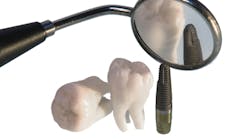Beginning in 2012, Dentistry IQ has periodically offered its readers the chance to explore tips from practice management experts that cover all areas of the dental practice, from patient relationships to the staff to financial concerns to front office matters to marketing strategies.
Whatever your role in the dental practice — whether you're a dentist, hygienist, front office worker, or even a consultant — there's sure to be something in this collection of tips that will help you as you continually commit to your job and practice.
The two previous incarnations of the 100 Tips articles have been big hits on the Dentistry IQ website — the original version still ranks as one of the top-read articles on our website. This fall, the Dentistry IQ editors decided to gather another round of tips. Due to a slight decrease in the number of tips we received this time around, and to increase clickability, we've decided to post each category of tips as a separate article. The separate articles will make it easier for readers to read only the tips that benefit them, although we urge you to read as many as you can!
-------------
Here are the top seven clinical tips from practice management experts:
When first I coined the term “decathlon dentistry”, the “learned few” were teaching, “You've got to find a niche and fill it!” My multitasking nature caused me to see each discipline in dentistry (orthodontics, pedodontics, endodontics, prosthodontics, periodontics, oral surgery, and restorative) as a holistic need to be provided in my own practice, not as separate pieces of a body to be farmed out to specialists who had given me a fruit basket at Christmas for sending them 100 sets of third molars each year. Referral reciprocation is the tip for specialists. For generalists: increase continuing education to achieve Decathlon Dentist status.
Dr. Bill Williams, DMD, MAGD
Solstice Dental Advisors
[email protected]
We seek technical simplicity and conservation of our patient’s teeth when he or she asks us to give them the smile they seek. This combination allows us to deliver a new smile at a very affordable fee because the technique allows for a quick improvement of their smile. We can then pass the savings on time onto our patient. We do a smile try-in so they can evaluate the new shape, color, and thickness. Then, we render treatment with no anesthetic, no temporaries, and only predictable enamel bonding. Consider minimal-prep veneers next time you have a patient asking about conservative smile-improving dentistry.
Dr. Michael Miyasaki
[email protected]
Periodontal disease and periodontal pathogens are associated with vascular disease and have been identified as causative for atherosclerosis. Restoring patients to pristine gingival health and maintaining that pristine health constitutes vascular disease prevention; it also improves glycemic control for diabetic individuals and constitutes prevention for pre-diabetic individuals. Diagnose and treat every patient, every time, with any level of periodontal disease. Don’t fiddle while your patients’ arteries are burning.
Richard H. Nagelberg, DDS
[email protected]
When a patient calls our office, most of us have trained our front desk personnel to determine if this is an acute problem or a chronic problem. How would you characterize a denture sore or a loose denture? In my office denture problems are an acute problem, especially if it concerns a new patient. These patients generally are experiencing persistent denture looseness or sores. Conventional root form implants give patients a great solution for these chronic problems. Root form implants do have limitations related to cost, anatomical considerations, the health of the patient, the dentist's technical ability, and length of time for integration.
Dr. Jeffrey C. Hoos, DMD
[email protected]
Create provisional mockups in porcelain instead of resin. Then, when everyone is satisfied with the “mockup”, it may be left without any further removal of mockup or tooth. Just polish the “porcelain mockup” and eliminate temps, anesthetic, margins, shoulders, and post-op sensitivity — and in some cases pulpitis. Finding an experienced and well-trained technician in creating prep-less veneers is essential to the SmileSimplicity way.
Bob Ibsen
[email protected]
Use the intraoral or digital camera constantly. Organize your hygiene appointments to include the taking or review of photographs showing:
· Dentistry diagnosed but incomplete
· New areas of concern since the last appointment
· Periodontal concerns
· Areas where advanced restorative care would be beneficial
· Views that show the patient’s present smile, to talk about (or show) what can be done through aesthetic alteration
Cameras and photography are your most important diagnostic and educational tools. Approximately 83% of learning takes place visually, so use the very best of all visual aids — photography.
Cathy Jameson, Founder, Jameson Management
www.jamesonmanagement.com
Perform a life-saving act. A study released by the National Cancer Institute confirms that HPV oropharyngeal cancers have risen an astounding 225% from 1998-2004. If this trend continues, oral cancer will become the nation’s leading HPV-related cancer within this decade, surpassing cervical cancer. Both the medical and dental communities have been alerted to this emerging pandemic. Subtle symptoms may include but are not limited to: a continuous sore throat, feeling that something is caught in the throat, unilateral ear pain, tongue that tracks to one side when protruded, continual lymph node enlargement, and hoarseness. Recognize the early warning signs and become acquainted with the new oral/oropharyngeal cancer profile. Your patients will be glad you did.
Jo-Anne Jones, President, RDH Connection Inc.
www.rdhconnection.com
To read more tips from practice management experts, click on the following links:
Clinical I Communication I Financial I Front Office I Having a Vision I Greatest Threat to Dentistry
Scheduling I Patient Relationships I The Staff I Practice Management I Leadership I Marketing






